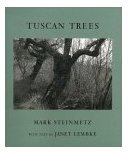|
Contents » Cover |
||
|
Reviews
The photographer Aaron Siskind found magic in rocks and walls needing fresh paint. Harry Callahan managed a similar extraordinary insight into the proper perspective of plants and trees. The latest Jargon publication, Tuscan Trees, offers another photographer working in a similar tradition: Mark Steinmetz. Indeed, publisher Jonathan Williams's introduction draws a parallel between the "shimmering animation" of Steinmetz's olive trees and Siskind's "anthropomorphic rocks and walls." Fixing each black and white photographic image is the Janet Lembke text; her eye sees any number of inherent possibilities found in a photograph's composition—dances, curtseys, whispered secrets, waterfalls. Text and photo become Emersonian, prose a transparent eyeball into the world of the photo. Steinmetz's olive trees are the animated trees in every haunted forest, limbs spread to envelop the startled traveler, and knots and holes become facial features. Many of the photos show groupings of trees, and the composition or arrangement often hints at some connection—a dance, a conversation—between or among the trees. One finds an example in the very first plate of two olive trees, one foregrounded, one in profile behind. The shape of the trees—hints of breasts and legs and dimpled thigh or buttock—suggest women convulsing, hysterical, arms held to the air and hair swinging. The Lembke text, a "bulletin from the first century A.D.," references a comment by Pliny the Elder: "an olive tree licked by a nanny-goat's tongue or nibbled when it's coming into bud will ever more be barren." Thus, the trees lament their barren fates. The Lembke text for the third photograph begins, "Acrobat, fan dancer, whirling dervish"; the photograph of the tree—bent to one side as if above the pelvis, upper trunk twisting toward the viewer and branches pinwheeling out from the trunk as if in a whirl—becomes a tree and something else, something animate. The texts provide a view into the photographic frame, a way into seeing an olive tree or group of olive trees. Lembke creates "an occult relation between man and the vegetable . . . They nod to me, and I to them," as Emerson writes in his essay "Nature." There are other visual marvels: ivy clothes a dead trunk as if in a shimmery cocktail dress; a tree stump covered in white-flowered vine suggests a bride (as Lembke's text makes clear). Lembke quotes Virgil and the Bible, makes references to ancient history and myths, and then there are wonderful puns and word play ("Three, a potent number: / trio, triumvirate, Trinity, / trees"). Lembke notes that the olive tree has outlasted "Etruscans, Romans, barbarians, grand dukes, kings, popes, holy Roman emperors, saints and martyrs, Fascists, Communists, Christian Democrats"; so too has Jargon outlasted the taste du jour of publishing's last 50 years. Lembke reminds us that the Indo-European root for tree and truth means "to be firm, to be solid." Tuscan Trees is another splendidly solid publication by a press that annually holds true to its firm aesthetic sensibility.
|
|||||
